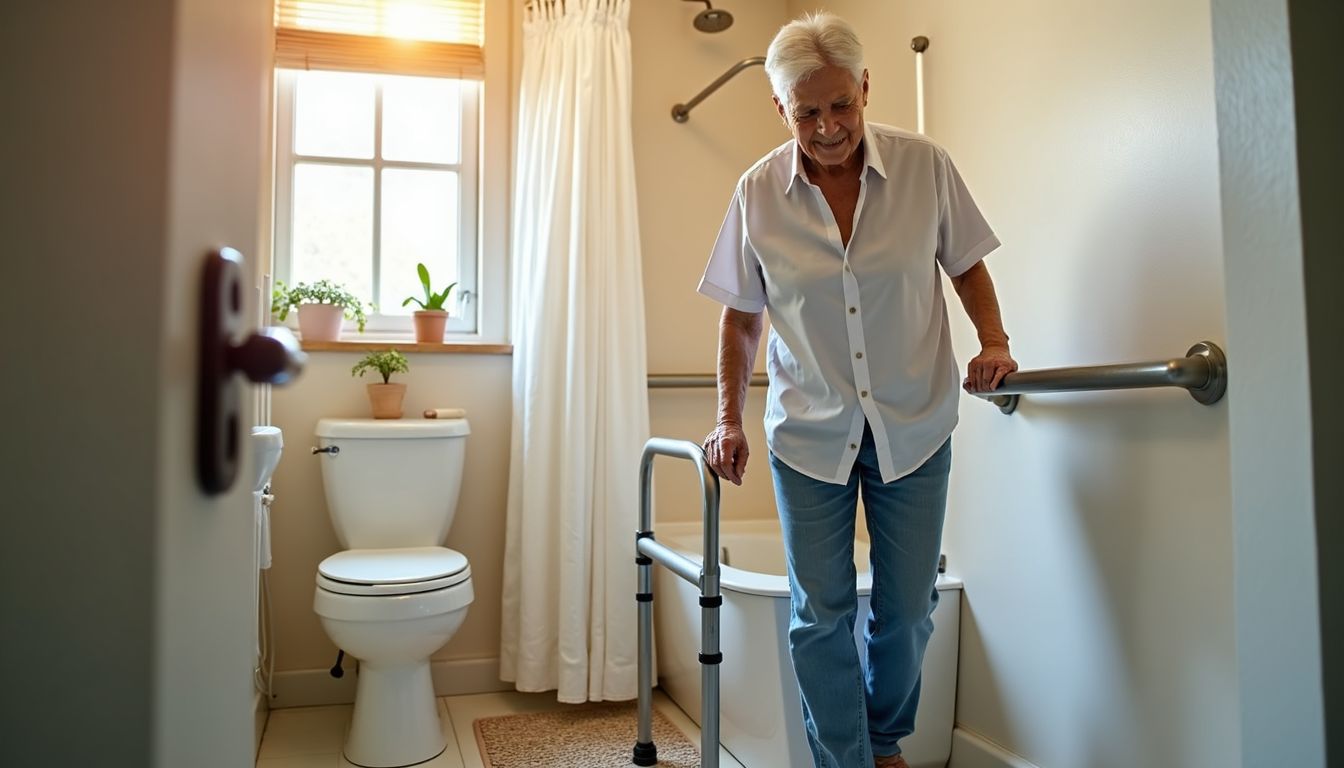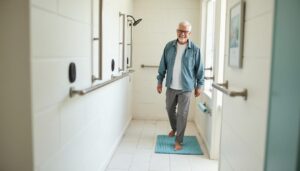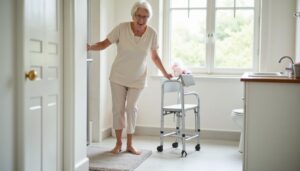Bathroom safety for seniors is one of the most important aspects of maintaining independence and preventing injuries at home. Bathrooms can be especially hazardous due to wet surfaces, poor lighting, and limited mobility. Simple changes like installing grab bars, using non-slip mats, and choosing a sturdy shower chair can dramatically reduce the risk of falls and make daily routines safer and more comfortable.
Bathrooms may seem harmless, but they are actually one of the most dangerous areas in a home for seniors. According to the CDC, In 2021, emergency departments recorded nearly 3 million visits for older adult falls. Slips, trips, and falls in this space can lead to serious injuries such as fractures, head trauma, or even hospitalization.
The combination of wet surfaces, smooth flooring, and limited support makes bathrooms a high-risk environment. Even everyday activities like stepping into the shower, reaching for toiletries, or getting up from the toilet can become dangerous without proper safety measures.
The good news is that simple adjustments and the right assistive products can drastically reduce these risks. Installing grab bars, using non-slip mats, and incorporating supportive devices like shower chairs and bedside commodes make it easier for seniors to maintain independence while staying safe.
For example, our reviews of the Best Shower Chairs for Seniors and Top 5 Bedside Commodes in 2025 highlight products designed specifically to reduce slips and provide stable support during bathroom routines.
By combining awareness, proper equipment, and consistent habits, caregivers and seniors can create a bathroom environment that is both safe and confidence-boosting.
Common Causes of Bathroom Accidents
Understanding why bathroom accidents happen is the first step toward preventing them. Seniors are particularly vulnerable due to age-related changes in balance, vision, and strength. The most common causes include:
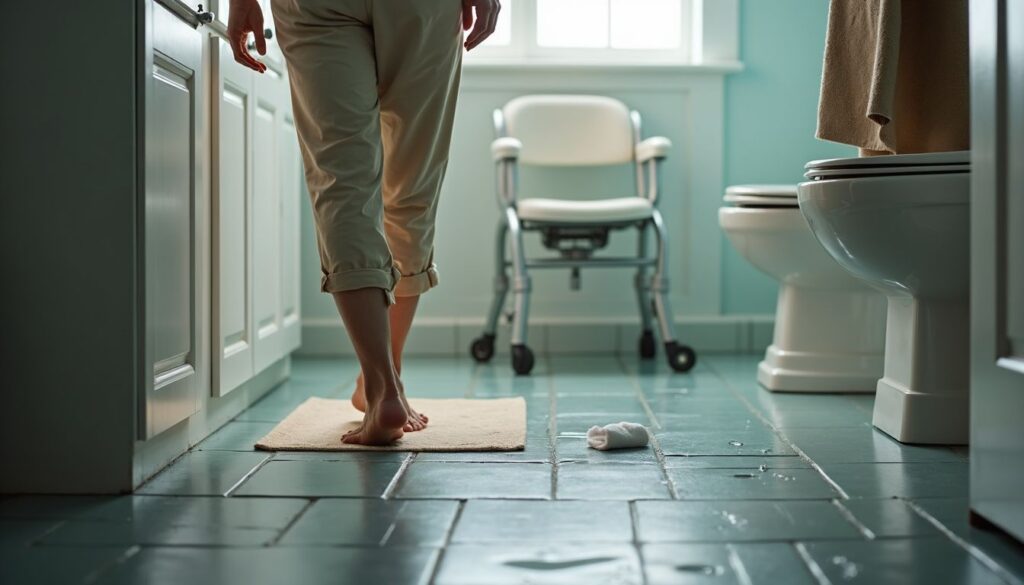
1️⃣ Slippery Floors and Mats
Wet tiles or rugs that shift easily are a leading cause of falls. Soap or water spills can make floors dangerously slick, especially for seniors with limited balance. Using non-slip mats and wiping up water immediately helps prevent accidents.
2️⃣ Wet Surfaces and Poor Drainage
Standing water in the shower or around the sink creates an unexpected hazard. Ensuring proper drainage and keeping surfaces dry reduces the risk of slipping.
3️⃣ Lack of Support
Many bathrooms don’t have grab bars near the toilet, bathtub, or shower. Without stable support, seniors can lose balance when sitting, standing, or stepping in and out of the shower. Installing grab bars or using a shower chair can dramatically improve safety.
4️⃣ Inadequate Lighting
Poor lighting can make it hard to see wet spots, rugs, or obstacles. Bright, even lighting — especially at night — is essential. Motion-sensor lights or night lights near the toilet and shower can provide extra safety.
5️⃣ Rushing or Multitasking
Many accidents happen when seniors are in a hurry or trying to do too much at once, like reaching for toiletries while standing on a wet surface. Encouraging a slow, mindful routine reduces the likelihood of slips or falls.
By addressing these common causes, caregivers can take proactive steps to make bathrooms much safer. Prevention combines awareness, product support, and daily habits, creating a space where seniors can maintain independence confidently.
Must-Have Safety Equipment
Equipping the bathroom with the right safety devices is one of the most effective ways to prevent slips, falls, and injuries among seniors. Here are the essentials:
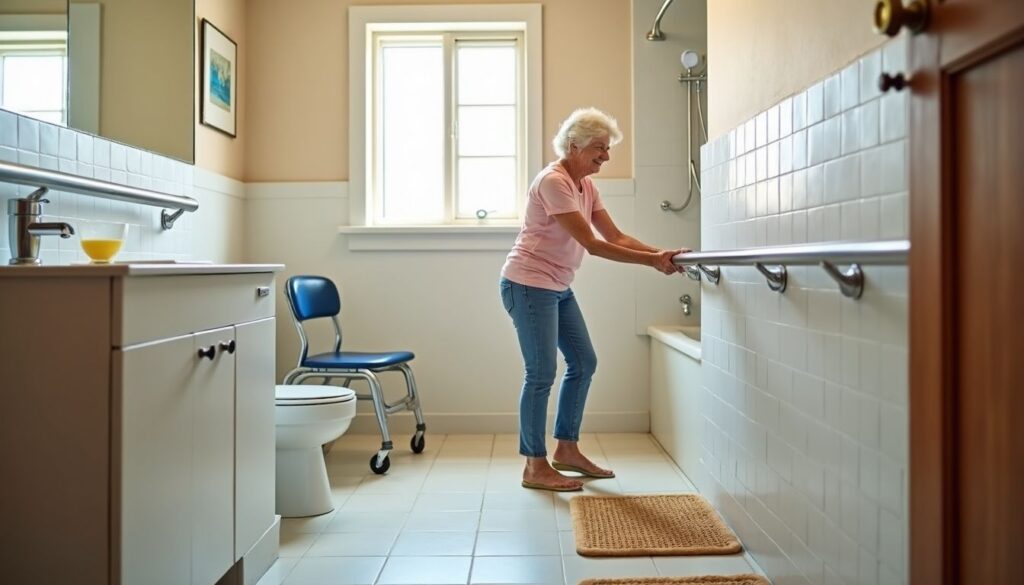
1️⃣ Grab Bars
Grab bars provide stable support when sitting, standing, or moving around the bathroom. They should be installed near the toilet, shower, and bathtub. For extra safety, choose bars with non-slip grips and ensure they are securely anchored to the wall.
2️⃣ Non-Slip Mats and Rugs
A slip-resistant mat in the shower and outside it is critical. Look for mats with strong suction cups or textured bottoms to prevent sliding. Avoid loose or small rugs that can easily shift.
3️⃣ Shower Chairs and Benches
For seniors with limited balance or stamina, a shower chair or bench allows them to sit safely while bathing. Many models come with adjustable height, back support, and armrests for extra comfort. Check out our guide on Best Shower Chairs for Seniors for top recommendations.
4️⃣ Raised Toilet Seats and Bedside Commodes
Raising the height of a toilet reduces strain on knees and hips and makes it easier for seniors to sit and stand. Bedside commodes are especially helpful for nighttime use or limited mobility. Our review of Top 5 Bedside Commodes in 2025 highlights options designed for safety and comfort.
5️⃣ Emergency Alert Devices
Installing waterproof call buttons or wearable emergency alert devices ensures that seniors can summon help immediately in case of a fall. This gives both seniors and caregivers peace of mind.
6️⃣ Proper Lighting
Good lighting is essential. Motion-sensor night lights near the toilet and shower provide visibility during nighttime visits without the need to turn on harsh overhead lights.
Using these safety devices together creates a comprehensive bathroom setup that significantly reduces the risk of accidents and allows seniors to maintain independence safely.
How to Set Up a Fall-Proof Bathroom
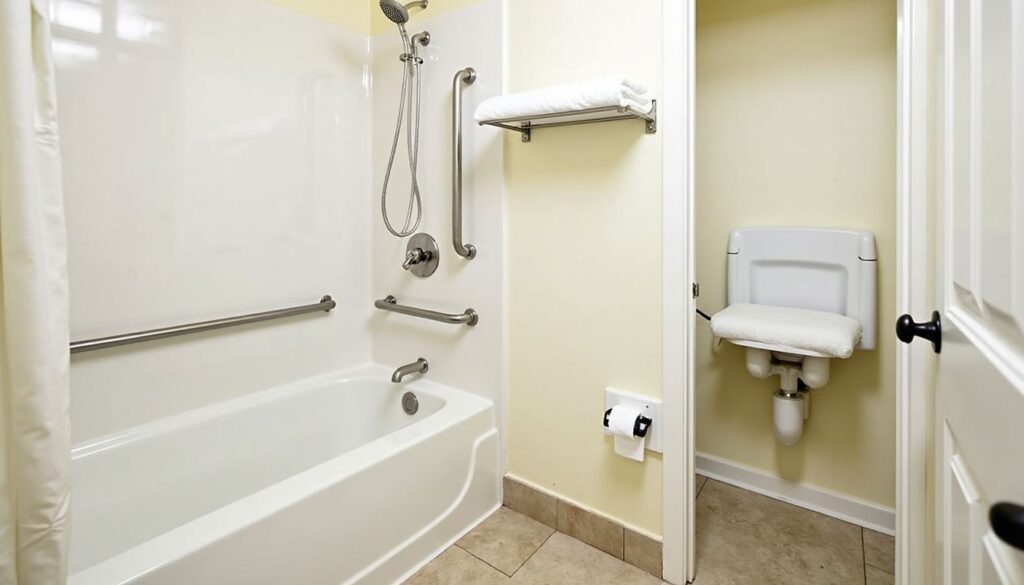
Creating a fall-proof bathroom involves more than just installing products — it’s about arranging the space thoughtfully to reduce hazards and make daily routines safer. Here’s a step-by-step guide:
1️⃣ Clear Walking Space
Remove unnecessary items like small rugs, laundry baskets, or clutter from the floor. Ensure there’s enough room to move freely without obstacles, especially around the toilet and shower area.
2️⃣ Install Grab Bars Strategically
Place grab bars near the toilet, inside the shower, and along the bathtub. Position them at heights that are comfortable for seniors to hold while sitting or standing. Check out our product guide on Best Shower Chairs for Seniors for chairs with built-in support options.
3️⃣ Use Non-Slip Mats and Rugs
Place slip-resistant mats inside and outside the shower or bathtub. Ensure mats have strong suction or textured backs to prevent sliding. Avoid small or loose rugs that could cause tripping.
4️⃣ Ensure Proper Lighting
Good lighting is essential to prevent missteps. Install bright overhead lights and consider motion-sensor night lights near the toilet or shower for nighttime use.
5️⃣ Keep Essentials Within Reach
Store soaps, shampoos, towels, and other daily necessities at waist or shoulder height to avoid bending or stretching. Use caddies, shelves, or shower organizers to keep items organized and accessible.
6️⃣ Consider Raised Toilet Seats or Bedside Commodes
For seniors with limited mobility, a raised toilet seat or bedside commode reduces the effort required to sit or stand safely.
7️⃣ Test the Setup
After installing safety devices and rearranging the space, walk through the bathroom with the senior to ensure everything is accessible, comfortable, and safe. Make adjustments as needed.
Following these steps helps create a safe, functional bathroom environment that minimizes risks and allows seniors to maintain independence with confidence.
Even the safest bathroom can become hazardous if safety equipment and surfaces aren’t maintained regularly. Consistent cleaning and checks are essential for preventing slips, falls, and injuries among seniors.
1️⃣ Inspect Grab Bars and Supports
Check all grab bars, handrails, and shower chairs weekly to ensure they are securely fastened. Loose bars or worn-out supports can fail unexpectedly and cause serious accidents.
2️⃣ Keep Floors and Mats Clean
Soap, shampoo, and water residue can make bathroom floors slippery. Wipe down surfaces daily and ensure non-slip mats are free of mildew and firmly in place. Replace mats if the backing starts to wear or peel.
3️⃣ Maintain Shower Chairs and Benches
If seniors use shower chairs or benches, clean them after every use with mild soap and water to prevent mold and bacteria buildup. Check height adjustment mechanisms and armrests for stability.
4️⃣ Check Bedside Commodes and Raised Toilet Seats
Bedside commodes should be emptied and cleaned regularly. Ensure that raised toilet seats are firmly attached and free from cracks or wear. Replace any parts showing signs of damage immediately.
5️⃣ Replace Worn or Damaged Items
Rugs, grab bars, or any bathroom accessories that are worn, slippery, or unstable should be replaced promptly. Regularly update equipment to maintain safety standards.
6️⃣ Schedule Periodic Safety Reviews
Set a reminder every few months to review the bathroom setup with the senior. Look for new hazards, and make adjustments as mobility, balance, or health conditions change.
Consistent maintenance ensures that all safety measures remain effective and reliable. A clean, well-checked bathroom creates a secure environment where seniors can maintain independence confidently.
Bathroom Safety Checklist for Seniors
A checklist helps caregivers and seniors stay proactive about bathroom safety. By reviewing this regularly, you can prevent accidents and maintain a secure environment.

✅ Flooring and Mats
-
Ensure all floors are dry and free of water spills
-
Use non-slip mats inside and outside the shower
-
Remove loose rugs or replace with non-slip versions
✅ Grab Bars and Supports
-
Grab bars installed near the toilet, bathtub, and shower
-
Check bars weekly for tightness and stability
-
Consider shower chairs or benches for added support
✅ Toilet Safety
-
Use raised toilet seats if needed
-
Keep bedside commodes clean and secure
-
Check all attachments for wear or looseness
✅ Lighting
-
Ensure bright, even lighting in all areas
-
Use motion-sensor or night lights for nighttime trips
✅ Accessibility of Essentials
-
Store soaps, shampoos, towels, and other necessities within easy reach
-
Avoid bending or stretching in risky positions
✅ Emergency Measures
-
Keep waterproof call buttons or alert devices accessible
-
Ensure caregivers are aware of emergency protocols
✅ Regular Maintenance
-
Clean floors, mats, and equipment regularly
-
Inspect grab bars, shower chairs, and commodes for damage
-
Replace worn or broken items immediately
By using this checklist, seniors and caregivers can reduce risks, prevent injuries, and create a more independent bathroom experience.
Conclusion: Combining Products, Habits, and Awareness
Creating a safe bathroom for seniors is not just about buying the right products — it’s about combining equipment, habits, and awareness to build a secure environment.
Investing in grab bars, non-slip mats, shower chairs, and bedside commodes provides essential support, but daily routines and mindful habits make all the difference. Encourage seniors to move slowly, reach for essentials carefully, and always use installed supports. This combination of tools and awareness dramatically reduces the risk of falls and injuries.
Caregivers play a key role by performing regular maintenance checks, ensuring lighting is sufficient, and keeping the bathroom clutter-free.
For broader safety guidelines, you can also refer to the CDC – Preventing Falls in Older Adults, which offers expert tips on reducing risks at home.
Final Thought 💭
Bathroom safety is a team effort — combining the right products, simple habits, and regular awareness checks empowers seniors to maintain independence confidently. With thoughtful planning and consistent care, falls and injuries can be prevented, making daily routines safer and stress-free for both seniors and caregivers.


